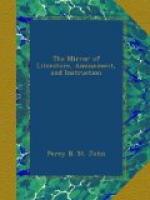In 1804, Dr. Henry delivered a course of lectures on chemistry, at Manchester, in which he showed the mode of producing gas from coal, and the facility and advantage of its use. Dr, Henry analyzed the composition and investigated the properties of carburetted hydrogen gas. His experiments were numerous and accurate, and made upon a variety of substances; and having obtained the gas from wood, peat, different kinds of coal, oil, wax, &c. he endeavoured to estimate the relative quantity of light yielded by each.
In 1805, Mr. Samuel Clegg, to whom the world is much indebted for the improvements he subsequently introduced into the manufacture of gas, having left Soho, directed his attention to the construction of gas apparatus. The first he erected was in the cotton mill of Mr. H Lodge, near Halifax, in Yorkshire. Mr. Josiah Pemberton, one of those ingenious men happily not rare in the centre of our manufactures, whose minds are perpetually employed on the improvement of mechanical contrivances, and who, as soon as they have accomplished one discovery, leave others to reap the benefit, and themselves pursue the chase alter new inventions, had for some time been experimenting on the nature of gas. A resident of Birmingham, his attention was probably roused by the exhibition at Soho; and such was the fertility of his invention, and his practical skill as a mechanic, that it has been observed by those who know him, that he never undertook to make an article without inventing an improvement in its construction. About 1806, he exhibited gas-lights in a variety of forms, and with great brilliance, at the front of his manufactory in Birmingham.
In 1808 he constructed an apparatus, applicable to several uses, for Mr. Benjamin Cooke, a manufacturer of brass tubes, gilt toys, and other articles. In 1808, Mr. Murdoch communicated to the Royal Society a very interesting account of his successful application of coal gas to lighting the extensive establishment of Messrs. Phillips and Lea. For this communication, Count Rumford’s gold medal was presented to him. Mr. Murdoch’s statements threw great light on the comparative advantage of gas and candles, and contained much useful information on the expenses of production and management.
Early in 1809, Mr. Samuel Clegg communicated to the Society of Arts his plan of an apparatus for lighting manufactories with gas, for which he received a silver medal. In this year also, Mr. Clegg erected a gas apparatus in Mr. Harris’s manufactory at Coventry.
It was natural to suppose that all these circumstances should eventually produce an impression on the country; consequently about this time much attention was excited towards gas-lighting, and much utility anticipated from a general application of it to public purposes. In this year 1809, accordingly, the first application was made to parliament for an act to incorporate a company, with the view of carrying on its processes




